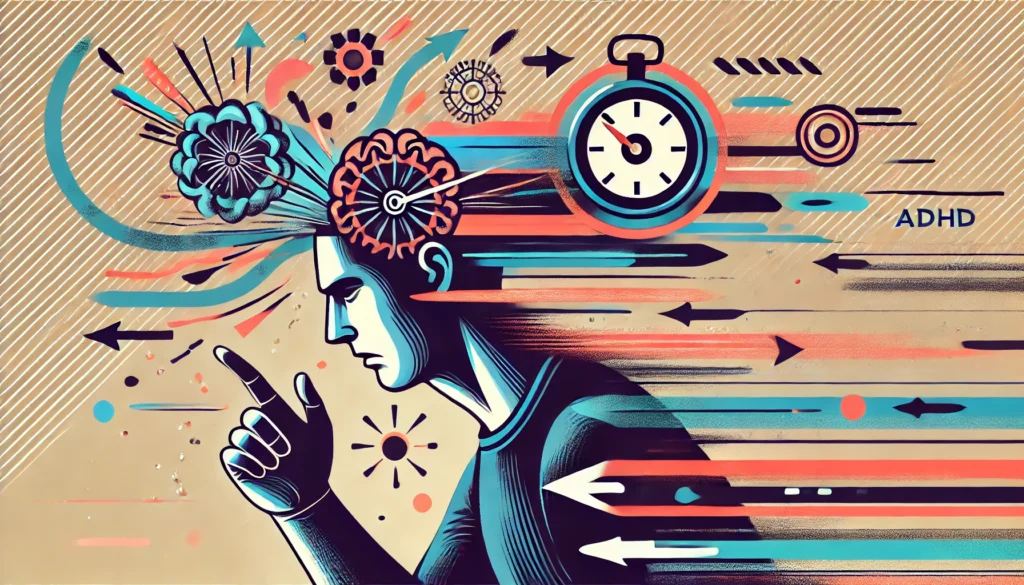ADHD, commonly associated with children, is a neurodevelopmental disorder that persists into adulthood for many individuals. The predominantly hyperactive-impulsive type is characterized by a pattern of hyperactivity and impulsive behaviors. While inattention is often present, it is the hyperactivity and impulsivity that are most prominent.
You may also like: Enhancing Concentration: Strategies for ADHD
The Historical Context of ADHD
Historically, ADHD was primarily diagnosed in children, with the assumption that symptoms would diminish with age. However, recent studies have illuminated that many adults continue to experience significant symptoms that impact their daily lives. The recognition of ADHD in adults has only gained traction in recent decades, shedding light on a population that was previously underserved.
The early focus on children meant that adult symptoms were often attributed to other issues, such as anxiety or stress. This misdiagnosis left many adults without the support they needed, exacerbating the challenges they faced. With evolving research, there’s now a better understanding that ADHD is a lifelong condition for many.
Evolution of Diagnostic Criteria
The diagnostic criteria for ADHD have evolved over the years, reflecting a deeper understanding of how the disorder manifests in adults. Initially, criteria were heavily based on child behavior, which led to many adults being overlooked. As research progressed, new guidelines were established to better capture adult experiences.
These updated criteria consider the unique ways ADHD symptoms can appear in adults, such as the internalization of hyperactivity. Adults may not exhibit overt hyperactive behaviors like children, but they often experience an ongoing sense of restlessness. This evolution in diagnostic criteria has been instrumental in improving recognition and treatment of ADHD in adults.
The Impact of Societal Perceptions
Societal perceptions have also played a role in the recognition of ADHD in adults. In the past, there was a stigma attached to mental health issues, including ADHD, which discouraged many from seeking help. As awareness has grown, so has acceptance, allowing more adults to come forward and receive the support they need.
This shift in perception has been facilitated by advocacy and awareness campaigns that highlight ADHD’s prevalence and impact. As society becomes more informed, there’s a greater push towards understanding and accommodating the needs of adults with ADHD, both in personal and professional settings.

Key Symptoms of Hyperactivity and Impulsivity
Recognizing the signs of ADHD in adults involves understanding the core symptoms associated with hyperactivity and impulsivity. These symptoms are not only indicative of ADHD but also provide insight into the challenges adults may face.
Hyperactivity Symptoms
Adults with hyperactivity often exhibit behaviors such as:
- Restlessness and Fidgeting: Unlike children who might run around excessively, adults may feel an internal restlessness, often manifesting as fidgeting or an inability to sit still.
Restlessness in adults can manifest as a constant need to move, whether it’s tapping a foot or frequently adjusting in a chair. This can be distracting not only for the individual but also for those around them. The inability to relax can lead to exhaustion and difficulty finding peace in quiet moments.
Fidgeting, though seemingly minor, is a significant indicator of hyperactivity in adults. It can impact workplace productivity and social interactions, as it often draws attention and may be perceived as a lack of focus. Understanding the need to fidget can help in developing coping strategies that allow for better concentration.
- Excessive Talking: This can be perceived as an inability to control speech, often leading to interrupting others or talking over them.
Excessive talking can be a double-edged sword, as it can both engage and overwhelm listeners. Adults with ADHD may struggle to regulate their speech, leading to misunderstandings or social faux pas. This symptom is often misinterpreted as rudeness, when in reality, it stems from an inability to inhibit speech impulses.
Managing excessive talking involves learning to recognize and control the urge to speak. Techniques such as active listening and mindfulness can be beneficial, helping individuals pause and consider the appropriate time to contribute to a conversation. These strategies can improve communication and interpersonal relationships.
- Difficulty Engaging in Quiet Activities: Activities that require calm and stillness may be particularly challenging, leading to avoidance or incomplete participation.
Adults with ADHD may find it difficult to engage in activities that require sustained calmness, such as reading or meditating. This challenge can lead to avoidance behaviors, where individuals shy away from situations that demand stillness. The inability to engage in quiet activities can impact relaxation and leisure time, contributing to stress and burnout.
Finding ways to incorporate movement into quiet activities can help, such as taking brief breaks during reading sessions or incorporating movement-based mindfulness practices. These adaptations allow for better engagement and enjoyment of activities that require focus and calm.
Impulsivity Symptoms
Impulsivity in adults can be more disruptive than hyperactivity, affecting decision-making and interpersonal relationships:
- Hasty Decision-Making: Making decisions without fully considering the consequences can lead to financial problems, career challenges, or strained relationships.
Impulsive decision-making is a hallmark of ADHD in adults and can have far-reaching consequences. Whether it’s making a large purchase without thinking it through or changing jobs on a whim, these decisions can lead to instability. The lack of forethought often results in regret and the need to backtrack, which can be both time-consuming and costly.
Learning to slow down and evaluate options is crucial for managing impulsivity. Tools such as decision-making frameworks or consulting with trusted individuals can provide the necessary pause to consider long-term implications. These practices can lead to more informed and beneficial choices.
- Interrupting Conversations: Impulsivity often manifests as interrupting others or blurting out answers, which can be socially disruptive.
Interrupting conversations is a common issue for adults with ADHD, as the impulse to speak can override the social norm of waiting one’s turn. This behavior can be off-putting to others, leading to social friction or misunderstandings. Recognizing this impulse and developing strategies to manage it is essential for improving social interactions.
Techniques such as active listening and setting conversational goals can help individuals with ADHD participate more effectively in discussions. These methods encourage patience and reflection, allowing for more meaningful and respectful exchanges.
- Impatience: Difficulty waiting for one’s turn or a tendency to become easily frustrated can impact both personal and professional interactions.
Impatience can manifest in various ways, from frustration during meetings to irritability in traffic. This symptom can strain personal relationships and hinder professional progress. The inability to wait can lead to rushed decisions or actions that are not well thought out.
Developing patience involves cultivating mindfulness and stress-reduction techniques. Practices like deep breathing or visualization can help manage impatience, leading to calmer and more effective responses in challenging situations.

Inattention and Impulsivity as Characteristics
While hyperactivity and impulsivity are prominent, inattention also plays a significant role in adult ADHD. The interplay between inattention and impulsivity can create a cycle of challenges that exacerbate one another.
The Role of Inattention
Inattention in adults may include:
- Disorganization: Difficulty managing tasks, time, and priorities often leads to chaos in daily life.
Disorganization is a common issue for adults with ADHD, impacting their ability to effectively manage daily tasks and responsibilities. This can result in missed appointments, late submissions, and a general sense of chaos. The inability to prioritize tasks can lead to feelings of overwhelm and frustration.
Strategies such as using planners or digital tools can help bring order to this chaos. Breaking tasks into manageable steps and setting reminders can improve time management and task completion. These techniques can enhance productivity and reduce stress.
- Forgetfulness: Misplacing items or forgetting important deadlines is common, impacting both personal and professional responsibilities.
Forgetfulness can be a significant barrier to success for adults with ADHD. Losing track of important items or dates can result in missed opportunities and strained relationships. This symptom is often perceived as carelessness, but it stems from challenges with memory and focus.
Implementing systems for organization, such as consistent places for important items and digital calendars for deadlines, can mitigate forgetfulness. These strategies help create structure and reliability, allowing individuals to better meet their obligations.
- Difficulty Sustaining Attention: Tasks that require prolonged focus are particularly challenging, often resulting in unfinished projects.
Sustaining attention is a core challenge for adults with ADHD, impacting their ability to complete tasks that require extended focus. This can lead to a cycle of starting projects without finishing them, resulting in frustration and decreased confidence. The inability to maintain concentration can also affect learning and professional growth.
Techniques such as the Pomodoro Technique, which involves working in short, focused bursts, can improve attention span. Regular breaks and varied activities can also help maintain engagement and productivity over time.
The Interconnection of Symptoms
The combination of inattention and impulsivity can be particularly detrimental. For instance, an individual may impulsively start a new project without completing previous ones due to inattention, leading to a cycle of unfinished tasks and heightened stress.
This interconnection of symptoms can create a feedback loop where one symptom exacerbates another. The impulsive initiation of tasks without planning can lead to disorganization and chaos, while inattention can prevent the completion of these tasks. This cycle can result in increased anxiety and a sense of failure.
Breaking this cycle requires a strategic approach that addresses both impulsivity and inattention. Techniques such as setting clear goals and deadlines, alongside regular self-assessment, can help manage these symptoms. By understanding the interconnected nature of their symptoms, individuals can develop more effective coping mechanisms.

Current Trends and Future Implications
The recognition of ADHD in adults is growing, and with it, the development of more sophisticated diagnostic tools and treatment options. This shift is crucial for providing adequate support and resources for those affected.
Emerging Diagnostic Tools
Advancements in neuroimaging and genetic research are paving the way for more precise diagnostics, potentially allowing for earlier and more accurate identification of ADHD in adults.
Neuroimaging techniques, such as MRI and PET scans, are being explored as tools to better understand the brain structures and functions associated with ADHD. These technologies have the potential to identify biomarkers that are indicative of the disorder, leading to more objective and reliable diagnoses.
Genetic research is also shedding light on the hereditary aspects of ADHD. By identifying specific genes linked to the disorder, researchers hope to develop genetic tests that can assist in diagnosis. These advancements could revolutionize the way ADHD is understood and treated, offering more personalized approaches to care.
Treatment Strategies and Support
Current treatments often involve a combination of medication, cognitive behavioral therapy (CBT), and lifestyle modifications. The future of ADHD treatment may include personalized medicine approaches, leveraging genetic and biomarker information to tailor interventions.
Medication remains a cornerstone of ADHD treatment, with stimulants and non-stimulants helping to manage symptoms. However, there’s a growing emphasis on behavioral therapies that equip individuals with skills to cope with daily challenges. CBT, in particular, has proven effective in addressing the negative thought patterns and behaviors associated with ADHD.
Lifestyle modifications, such as regular exercise and a balanced diet, also play a crucial role in managing symptoms. These holistic approaches are increasingly recognized for their ability to support mental and physical well-being, providing a comprehensive strategy for living with ADHD.
Practical Advice for Managing Symptoms
For adults navigating ADHD, understanding and managing symptoms is key to improving quality of life. Here are some strategies that may help:
- Structured Environment: Creating a structured daily routine can help manage disorganization and forgetfulness.
A structured environment provides predictability and reduces the cognitive load associated with decision-making. By establishing consistent routines, individuals can better manage their time and responsibilities. This structure helps minimize chaos and improves overall productivity and well-being.
Setting clear and achievable goals within this structure can enhance motivation and focus. By breaking larger tasks into smaller, manageable steps, individuals can track their progress and celebrate achievements, fostering a sense of accomplishment and reducing overwhelm.
- Mindfulness and Relaxation Techniques: These can reduce restlessness and improve focus, helping to mitigate the impact of hyperactivity.
Mindfulness practices, such as meditation and deep breathing exercises, can help calm the mind and reduce restlessness. These techniques encourage present-moment awareness, allowing individuals to focus on the task at hand and reduce impulsivity.
Incorporating relaxation techniques into daily routines can also alleviate stress and improve emotional regulation. Practices like yoga or tai chi combine physical movement with mindfulness, offering a holistic approach to managing ADHD symptoms and enhancing overall well-being.
- Professional Support: Engaging with healthcare professionals who specialize in ADHD can provide tailored strategies and support.
Working with professionals such as psychiatrists, psychologists, or ADHD coaches can provide valuable insights and support. These experts can help individuals understand their symptoms and develop personalized strategies to manage them effectively.
Therapeutic approaches, such as cognitive behavioral therapy, can also address specific challenges related to ADHD, such as negative thinking patterns or impulsive behaviors. By engaging with professional support, individuals can build a toolkit of strategies to navigate the complexities of ADHD and improve their quality of life.
Conclusion
ADHD predominantly hyperactive-impulsive type in adults presents unique challenges that require a nuanced understanding. By recognizing the signs and seeking appropriate support, individuals can effectively manage their symptoms and lead fulfilling lives. As research continues to evolve, the hope is for more comprehensive solutions that cater to the diverse needs of adults with ADHD.
In conclusion, whether you are a health and wellness coach, a science journalist, or a biohacker, understanding the complexities of hyperactivity and impulsivity in adults is crucial. This knowledge not only empowers you to provide better support and information but also contributes to a broader understanding of ADHD in society. As awareness and research progress, the potential for improved diagnosis, treatment, and support continues to grow, offering hope and relief to those affected by ADHD.
Further Reading:
Attention-Deficit/Hyperactivity Disorder, Predominantly Hyperactive in Adults
Hyperactive & Impulsive ADHD Type: Explained
Important Note: The information contained in this article is for general informational purposes only, and should not be construed as health or medical advice, nor is it intended to diagnose, prevent, treat, or cure any disease or health condition. Before embarking on any diet, fitness regimen, or program of nutritional supplementation, it is advisable to consult your healthcare professional in order to determine its safety and probable efficacy in terms of your individual state of health.
Regarding Nutritional Supplements Or Other Non-Prescription Health Products: If any nutritional supplements or other non-prescription health products are mentioned in the foregoing article, any claims or statements made about them have not been evaluated by the U.S. Food and Drug Administration, and such nutritional supplements or other health products are not intended to diagnose, treat, cure, or prevent any disease.


